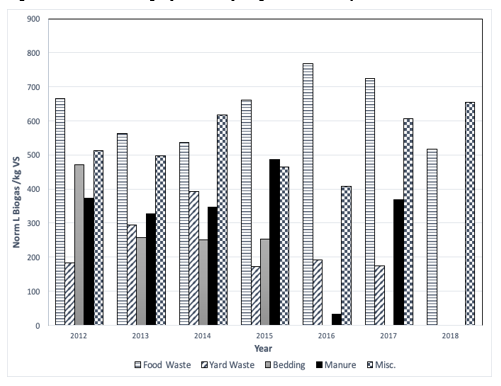Standardized Laboratory Testing for Biomethane Potential
- 1. Environmental Research and Innovation Center, University of Wisconsin Oshkosh, USA
RESULTS AND DISCUSSION
The four types of feedstocks were analyzed for both methane gas quality and total biogas production from the years 2012- 2018. The average methane productions for food waste, yard waste, bedding and manure were 68.7%, 65.3%, 65.9% and 62.6%, respectively. As can be seen from Table 1 and Figure 1, food waste consistently showed the highest quality in terms of methane content, while manure possessed the lowest methane content. Intuitively, this makes sense as these manure materials have already been digested via the animal it came from, while the food waste has not. All four feedstock groups showed methane gas qualities that were relatively good, meaning they were above 60%. This would be expected as all were being evaluated for addition to an anaerobic digestion system. Results for each year can be found in Table 1
Table 1: Methane concentration (%) found during biomethane potential laboratory testing.
|
|
2012 (n=17) |
2013 (n=7) |
2014 (n=12) |
2015 (n=8) |
2016 (n=12) |
2017 (n=3) |
2018 (n=16) |
Average |
Range |
|
Food Waste |
68.6 |
71.2 |
71.1 |
70.6 |
68.4 |
64.4 |
67.0 |
68.7 |
6.8 |
|
Yard Waste |
65.6 |
65.8 |
67.7 |
65.5 |
64.1 |
62.9 |
NA |
65.3 |
3.7 |
|
Bedding |
61.4 |
70.7 |
69.6 |
62.5 |
NA |
NA |
65.3 |
65.9 |
9.3 |
|
Manure |
NA |
59.4 |
69.7 |
60.8 |
64.8 |
56.9 |
64.1 |
62.6 |
12.8 |
|
Misc. |
67.6 |
73.4 |
68.1 |
65.2 |
58.8 |
64.4 |
64.5 |
66.0 |
14.6 |
Abbreviations: NA: Not Applicable
and Figure 1.
Figure 1: Methane concentration (% v/v) found in biomethane potential testing by various feedstock source and year (n=75).
Total biogas production is normalized for either TS L/kg or VS L/kg which allows for the physical properties of the feedstock to be taken into account when reporting results (Table 2).
Table 2: Biogas yield in normalized liters of biogas per kg TS.
|
|
2012 (n=17) |
2013 (n=7) |
2014 (n=12) |
2015 (n=8) |
2016 (n=12) |
2017 (n=3) |
2018 (n=16) |
Average |
Range |
|
Food Waste |
611.4 |
522.5 |
448.7 |
547.4 |
680.3 |
637.5 |
473.5 |
560.2 |
231.6 |
|
Yard Waste |
147.0 |
271.3 |
245.0 |
124.0 |
168.0 |
159.5 |
NA |
185.8 |
147.3 |
|
Bedding |
335.6 |
192.3 |
233.0 |
229.0 |
NA |
NA |
238.3 |
245.6 |
143.3 |
|
Manure |
NA |
338.0 |
197.0 |
235.0 |
396.1 |
3.0 |
262.0 |
238.5 |
393.1 |
|
Misc. |
446.8 |
425.3 |
465.1 |
421.6 |
249.7 |
553.5 |
578.2 |
448.6 |
328.5 |
Abbreviations: TS: Total Solids, NA: Not Applicable.
(Table 3).
Table 3: Biogas yield in normalized liters of biogas per kg VS.
|
|
2012 (n=17) |
2013 (n=7) |
2014 (n=12) |
2015 (n=8) |
2016 (n=12) |
2017 (n=3) |
2018 (n=16) |
Average |
Range |
|
Food Waste |
665.4 |
563.5 |
537.4 |
661.9 |
767.3 |
725.0 |
517.5 |
634.0 |
249.8 |
|
Yard Waste |
183.0 |
295.3 |
393.3 |
173.0 |
191.0 |
173.5 |
NA |
234.9 |
220.3 |
|
Bedding |
470.7 |
257.8 |
250.5 |
253.0 |
NA |
NA |
270.0 |
300.4 |
220.2 |
|
Manure |
NA |
372.0 |
326.0 |
346.0 |
486.8 |
32.0 |
369.2 |
322.0 |
454.8 |
|
Misc. |
512.8 |
497.7 |
616.7 |
463.5 |
408.6 |
605.9 |
653.9 |
537.0 |
245.3 |
Abbreviations: VS: Volatile Solids, NA: Not Applicable.
This is a critical standardization of biogas production based on organic solids content (volatile solids) as the loading of the feedstock in industrial-scale systems are based on solids and volatile solids content [10]. The mean total biogas productions TS L/kg for food waste, yard waste, bedding and manure were 560 L/kg, 186 L/ kg, 246 L/kg, and 288 L/kg respectively and results can be seen in Table 2 and Figure 2.
Figure 2: Normalized biogas production per kg TS for various years and feedstock sources (n=75).
The mean total biogas production VS L/ kg for food waste, yard waste, bedding and manure were 634 L/ kg, 235 L/kg, 300 L/kg and 370 L/kg respectively. Table 3 and Figure 3
Figure 3: Normalized biogas production per kg VS for various years and feedstock sources (n=75).
show results VS L/kg. Food waste had the greatest overall biogas mean of the four feedstock groups while yard waste saw the least amount of biogas produced per kg/VS. Both manure and yard waste showed the greatest variability in the biogas quantity from the BMP results (Table 2,3). This is understandable when one considers the various types of yard waste that could be included from fresh cut grass to old leaves to more woody debris. Additionally, manure can also be highly variable depending the operation where it originated in terms of cattle quantity, cattle feed, manure age, manure treatment, etc. Thus, while manure seems like a homogeneous feedstock, it could vary greatly. In comparison to each feedstocks’ methane results, which all came back in the high range, we did not see the same data results when it came to biogas production. All four feedstock types fell into the moderate to low categories [11]. While most of the feedstocks tested categorized into manure, bedding, food waste, and yard waste there were numerous other organic substrates that were placed in a miscellaneous category.
CONCLUSION
Because the standard method used for this type of testing is not well regulated in the United States, there is a lot of variation in testing systems in laboratories. This data set is a standardized group of biogas quality and quantity data that were collected over a seven year time span using consistent methodologies. The data shown here is not meant as a resource in lieu of laboratory testing, but rather a summary of results using a standardized set of conditions. This should help others interpret their results and how they may compare to similar (or different) products. It is important to understand, while there are comparisons and mean values for the feedstock groups, the ranges shown in the data illustrate the need for testing feedstock as even seemingly similar feedstocks may differ due to unforeseen parameters.
In the future, this data set can be expanded, and the miscellaneous feedstock group can be delineated into more detailed groups. Additional data collection and refinement of feedstock in the major groups can be conducted as the groups get larger with more data. These delineations can be based on a number of possible chemical and/or physical characteristics. In summary, the value of this BMP data is that it provides a unique look at a number of feedstocks being evaluated for BMP, over a number of years, and using a standardized method. It will be built upon moving forward.
REFERENCES
- Korres N, O'Kiley P, Benzie J. Bioenergy Production by Anaerobic Digestion: Using Agricultural Biomass and Organic Wastes; Earthscan, Abingdon, Oxon. 2013.
- Daelman MR, Van Voorthuizen EM, Van Dongen UG, Volcke EI. Van Loosdrecht MC. Methane emission during municipal wastewater treatment. Water Res. 2012; 46: 3657-3670.
- Goodrich. Anaerobic Digester Systems for Mid-Sized Dairy Farms, The Minnesota Project, St. Paul, MN, USA. 2005. 1-46.
- Manyi Loh C, Mamphweli S, Meyer E, Okoh A, Makaka G, Simon M. Microbial anaerobic digestion (bio-digesters) as an approach to the decontamination of animal wastes in pollution control and the generation of renewable energy, Int J Environ Res Public Health. 2013; 10: 4390-4417.
- Kleinheinz G. Personal Communication.
- Bioprocess Control. AMPTS Operational Manual, Lund, Sweden. 2015.
- Deutsches Institut fu?r Normung (DIN), 2015a. DIN 38414-18. German standard methods for the examination of water, waste water and sludge; sludge and sediments (group S) — de- termination of adsorbed organically bound halogens. 2015.
- Deutsches Institut fu?r Normung (DIN), 2015b. DIN 12879, German standard methods for the ex- amination of water, waste water and sludge. 2015.
- Deutsches Institut fu?r Normung (DIN), 2015c. DIN 12880, German standard methods for the ex- amination of water, wastewater and sludge. 2015.
- Pham CH, Vu CC, Sommer SG, Bruun S. Factors affecting process temperature and biogas production in small-scale rural biogas digesters in winter in northern Vietnam. Asian-Australas J Anim Sci. 2014; 27: 1050-1056.
- Deublein D, Steinhauser A. Substrates. Biogas from waste and renewable resources: An introduction. second edition. 2010; 55-84.
ABSTRACT
The increased need for biomethane potential testing across the country has led to a number of laboratory methods being developed, but there is no clear standardization of these tests in the United States. However, standardized biomethane potential (BMP) testing procedures do exist; examples are the German DIN methods. Due to the lack of standardization, there is a need for better understanding of feedstocks being evaluated for BMP and a better comparison of lab results using common methodologies. This study presents a comparison of four different types of common feedstock groupings: food waste, yard waste, animal bedding material, and manure evaluated for BMP using a common method over a number of years. Total biogas production was normalized for either TS L/kg or VS L/kg. The mean total biogas productions TS L/kg for food waste, yard waste, bedding and manure were 560 L/kg, 186 L/kg, 246 L/kg, and 288 L/kg, respectively. The mean total biogas production VS L/kg for food waste, yard waste, bedding and manure were 634 L/kg, 235 L/ kg, 300 L/kg and 370 L/kg, respectively. Both manure and yard waste showed the greatest variability in the biogas quantity from the BMP results. Food waste showed the highest quality in terms of methane content and the greatest biogas concentration when normalized for solids such as VS or TS.
KEYWORDS
• Anaerobic digestion
• Biomethane potential
• Methane
• Biogas
CITATION
Richter M, Thiel C, Kleinheinz G (2020) Standardized Laboratory Testing for Biomethane Potential. Chem Eng Process Tech 5(1): 1058.
ABBREVIATIONS
BMP: Biomethane Potential; TS: Total Solids; VS: Volatile Solids; FOG: Fat, oil, and grease; NA: Not Applicable.
INTRODUCTION
Anaerobic digestion is the microbial conversion of organic materials to gaseous compounds such as methane and carbon dioxide in the absence of oxygen [1]. This process has been well known for thousands of years and is used in wastewater treatment facilities, industrial processing, and farm applications worldwide [2]. When one considers the use for anaerobic digestion, they need to understand the behavior and performance of the feedstock in the anaerobic digestion process [3]. For example, there are many manure-based digesters, but by changing the operation of the digester, feed of the cattle, processing of the manure, etc., it may change the biogas output from the digester and the economic viability of the system [4]. Compound that with the need to sometimes add feedstocks as co-substrates, operators need to understand how feedstocks will (or won’t) impact the overall performance of their system. One way to begin an understanding of unproven feedstocks is to conduct biomethane potential (BMP) testing in a laboratory. This testing should provide one with accurate information on the biogas quantity and quality of the feedstock being tested. From these data an operator can make informed decisions on their facility and the operations with these materials. Lab-based testing is fairly straightforward, but there is a lack of quality standardized methodologies in many parts of the world. This results in retesting materials and a lack of ability to compare results between methods and testing facilities. When a facility operator sends samples for analysis, they often ask how their results compare to other results of similar make-up [5]. Having a lack of standardization makes these comparisons difficult at best.
While there are some vague methods available for BMP determinations, such as semi-automated BMP processes [6], the German DIN methods [7-9] are much more defined and more rigorous in the quality control measures implemented as part of the method. The data presented contains various feedstocks submitted by external partners for BMP analysis over a seven year period. As part of this testing, it was relatively simple to characterize the feedstocks into several broad categories. These are: manure, food waste, animal bedding, and miscellaneous. The miscellaneous category contains a wide array of materials such as fats, oils, and greases (FOG), wood waste, biobased plastics, and a myriad of other materials being investigated for anaerobic decomposition.
The overarching objective of this study is to provide a summary of some BMP data for various feedstocks, over numerous years, using a standardized BMP testing methodology. Specifically, we will evaluate the total volume and quality of biogas produced by various groups of feedstock material over several years.
MATERIALS AND METHODS
The method used for lab BMP testing in this study is the standard method DIN 38414 methods [7-9] utilizing an eudiometer for gas displacement and a hand-held gas meter for in-line gas quality measurements. In brief, the batch fermentation test is carried out using an 800 mL eudiometer filled with an acidic (pH<2) pH indicator solution to measure gas production via displacement, 2 liter borosilicate glass fermentation reactor, and 1 liter borosilicate glass screw cap flask with hose barb at the bottom which holds the extra pH indicator solution for equalizing the eudiometer. The entire system operates for a minimum of 28 days in a temperature-controlled water bath at 38 ± 1°C. The fermentation reactors required for a test series are filled with 1.9 liters of seed inoculum with a total solids content of 2-4% (percolate from the UW Oshkosh biodigester).
Prior to loading test samples into the reactors, 1.9 liters of fresh seed inoculum is loaded into the reactors and incubated in the 38 ± 1°C water bath for a minimum of two weeks. This is done to “starve” the seed inoculum prior to loading samples. This helps assure that the biogas arising during the actual testing is due to the feedstock being added and not the background inoculum. The eudiometer is tested for the presence of oxygen halfway through the starvation period so the lab can guarantee the eudiometer is capable of maintaining anaerobic conditions. Once the two week starvation has passed, the sample is loaded into the reactor at a rate of 3.00 kg/m3 dry weight and then agitated in the reactor to thoroughly mix the sample with the seed inoculum. Feedstock sample testing is conducted in duplicate or triplicate. In addition to the test samples, a positive control (microcrystalline cellulose) and negative control (percolate only) are analyzed in duplicate in each bath. Thus, results are either mean value of duplicate or triplicate samples.
Each eudiometer is monitored daily and biogas is recorded based on gas displacement of the pH indicator solution in each tube. Once biogas in the eudiometer has exceeded 400 mL in volume, a gas quality reading may be recorded, and the eudiometer may be zeroed. Biogas quality measurements are taken using a GasData GFM meter which is connected directly up to the sample port with a gas-tight stopcock on the eudiometer. The gas meter would sample for at least 30 seconds or until a stable reading is obtained and able to be recorded. The meter is capable of reading percent (+/- 0.1%) methane (CH4 ), percent carbon dioxide (CO2 ), percent oxygen (O2 ), and hydrogen sulfide (H2 S) in parts per million. On day 28 a final gas reading is taken. The sample and seed inoculum mixture, or “digestate”, is then removed from the reactor and analyzed for pH to make sure no pH indicator solution has made contact with the sample. The sample can then be kept for further analytical testing or discarded. All data is recorded into an Excel database where calculations are performed to normalize the data based on temperature and pressure. All test sample results have the negative control samples subtracted from their results to account for background anaerobic digestion due to the inoculum. Additionally, gas sample data is corrected for temperature and atmospheric pressure. Thus, all results are the biogas production of the test samples corrected for temperature and pressure with background factors subtracted.









































































































































